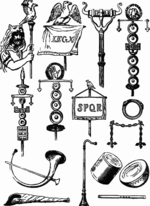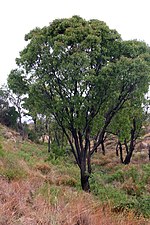In some rodents, squamae are small tubercles resembling scales on the sole of the hindfeet. Among oryzomyine rodents, their development is variable; most...
2 KB (179 words) - 00:09, 28 July 2021
of the temporal bones and the dorsum sellae; laterally by the temporal squamae, sphenoidal angles of the parietals, and greater wings of the sphenoid...
8 KB (979 words) - 23:56, 15 October 2023
chest. The individual scales used to construct Roman armour are called squamae or squama. During Roman times, scale armour (lorica squamata) was a popular...
15 KB (1,911 words) - 09:09, 5 April 2024
prominently in the 1st and 2nd centuries AD. The individual scales, called squamae were very small scales made of either iron or brass. Occasionally, they...
5 KB (619 words) - 23:58, 11 August 2024
specific epithet derives from the many bracteoles, or ‘scales’ (Latin: squamae, with the diminutive suffix -ulus) that subtend the flowers. The plant...
2 KB (195 words) - 08:55, 30 July 2024
in the family Agromyzidae. It is found in the Palearctic. Wings milky. Squamae with white borders and vestiture. Last segment of vein 5 (Cu A1 equal to...
1 KB (120 words) - 16:08, 19 September 2021
mid-thigh length with the shoulder doublings or cape. The individual scales (squamae) were either iron or bronze, or even alternating metals on the same shirt...
41 KB (5,550 words) - 10:15, 23 August 2024
of the wing base in some Diptera there is a pair of membranous lobes (squamae, or calypteres) known as the alula. The alula is well developed in the...
94 KB (11,615 words) - 19:50, 29 September 2024
Portion of spike with unexpanded flowers 2. Petal and stamen 3. Pistil and squamae 4. Ovary laid open to show the solitary ovule 5. Nut with persistent style...
3 KB (319 words) - 14:04, 2 September 2022
of the wing base in some Diptera, there is a pair of membranous lobes (squamae, or calypteres) known as the alula. The alula is well developed in the...
129 KB (17,125 words) - 13:34, 2 September 2024
larger (even holoptic) eyes, whereas the females have normal eyes. The squamae are disproportionately large, completely covering the halteres, and the...
9 KB (938 words) - 05:26, 17 January 2024
stigma is luteous, meaning it has a light to medium greenish tinge. The squamae are whitish, with a pale yellow border and yellow fringe, and have short...
9 KB (1,087 words) - 20:49, 11 December 2023
These lirae are closely beset with compressed spines, which resemble squamae, with very fine growth striae in the interstices. The periphery has a very...
3 KB (258 words) - 05:31, 30 June 2024
blue, green or purple reflections. Wings more or less yellow at the base. Squamae with long marginal cilia. Black halteres. Short subdiscoid abdomen. Female...
3 KB (240 words) - 02:09, 26 May 2024
some Diptera – the two basal lobes are called the calypteres (also termed squamae, squamulae). The proximal lobe is called the lower calypter (or basicalypter...
36 KB (4,190 words) - 09:14, 9 August 2024
mesonotum are more distinct, silvery green. Wings Wings slightly smoky. The squamae are whitish and halteres are yellowish. Legs The first tarsal joint of...
3 KB (384 words) - 16:43, 10 May 2024
wing's area. The remainder of the wing is colourless and transparent. Its squamae and squamal fringe are brown to dark brown. In 2015, Evenhuis and D. J...
16 KB (1,387 words) - 11:22, 10 July 2024
imbricated. The nodes on the upper carina become little raised hollow rounded squamae on the second whorl. The aperture has a reflexed and thickened margin....
4 KB (393 words) - 02:22, 1 July 2024
those of apes, with smaller individual cells. The Daka calvaria temporal squamae measure at approximately 5.7mm thick centrally. The posterior temporal...
8 KB (874 words) - 08:18, 6 September 2024
closely covered with a row of granules, having the character of compressed squamae on the principal lirae. This sculpture extends also over the whole body...
3 KB (384 words) - 13:56, 4 March 2021
hindfeet, longer than in T. talamancae, with usually smooth soles (lacking squamae, which are present in T. talamancae). The three middle digits are much...
31 KB (3,760 words) - 19:23, 4 February 2022
extensively microtrichose, with cells br and bm almost entirely bare. The squamae have rather long, light yellow pile. Legs The front and middle femora are...
6 KB (661 words) - 23:41, 26 May 2024
third longitudinal ( R4+5) vein before the tip of the second vein.. The squamae is tinged with yellow, the border and fringe of the same color. Halteres...
7 KB (714 words) - 03:39, 28 May 2023
a character shared only with Sooretamys angouya among oryzomyines. The squamae, small structures resembling scales that cover the soles of the hindfeet...
16 KB (2,185 words) - 22:48, 5 October 2023
morphological differences; most animals are dark green and have only very small squamae in the grooves of the abdominal tergites. Other animals are red, and have...
9 KB (863 words) - 13:14, 19 November 2021
upper spiral, round beads on the median one and compressed, spinelike squamae (decumbent scales) on the third spiral or peripheral keel. On the body...
3 KB (320 words) - 03:02, 1 July 2024
distinctly luteous (light to medium greenish tinge) ; stigma yellowish. Squamae and halteres white." from Williston Canada, United States. (See range map...
4 KB (367 words) - 15:22, 1 February 2024
with the veins at the base and in front yellow. The stigma is yellow. The squamae Calypter are whitish, with a yellow border and pale yellow fringe. The...
5 KB (559 words) - 07:10, 2 April 2024
hairy, but the underside is naked and covered with small irregularities (squamae). The pads are generally poorly developed, as are the ungual tufts. Interdigital...
50 KB (5,891 words) - 11:37, 21 January 2024
cross-vein (r-m) is slightly clouded with brown. The stigma is yellow. The squamae calypters are white with yellow border and pallid fringe. The halteres...
6 KB (731 words) - 23:07, 29 February 2024


























